
Water heating and treatment solutions company A.O. Smith (NYSE:AOS) missed Wall Street’s revenue expectations in Q4 CY2024, with sales falling 7.7% year on year to $912.4 million. The company’s full-year revenue guidance of $3.85 billion at the midpoint came in 3.4% below analysts’ estimates. Its non-GAAP profit of $0.85 per share was 4.8% below analysts’ consensus estimates.
Is now the time to buy A. O. Smith? Find out by accessing our full research report, it’s free.
A. O. Smith (AOS) Q4 CY2024 Highlights:
- Revenue: $912.4 million vs analyst estimates of $957.1 million (7.7% year-on-year decline, 4.7% miss)
- Adjusted EPS: $0.85 vs analyst expectations of $0.89 (4.8% miss)
- Adjusted EBITDA: $190.3 million vs analyst estimates of $196.5 million (20.9% margin, 3.2% miss)
- Management’s revenue guidance for the upcoming financial year 2025 is $3.85 billion at the midpoint, missing analyst estimates by 3.4% and implying 0.8% growth (vs -0.9% in FY2024)
- Adjusted EPS guidance for the upcoming financial year 2025 is $3.75 at the midpoint, missing analyst estimates by 6.8%
- Operating Margin: 17.1%, in line with the same quarter last year
- Free Cash Flow Margin: 21%, similar to the same quarter last year
- Market Capitalization: $10.04 billion
Company Overview
Credited with the invention of the glass-lined water heater, A.O. Smith (NYSE:AOS) manufactures water heating and treatment products for various industries.
HVAC and Water Systems
Many HVAC and water systems companies sell essential, non-discretionary infrastructure for buildings. Since the useful lives of these water heaters and vents are fairly standard, these companies have a portion of predictable replacement revenue. In the last decade, trends in energy efficiency and clean water are driving innovation that is leading to incremental demand. On the other hand, new installations for these companies are at the whim of residential and commercial construction volumes, which tend to be cyclical and can be impacted heavily by economic factors such as interest rates.
Sales Growth
A company’s long-term performance is an indicator of its overall quality. While any business can experience short-term success, top-performing ones enjoy sustained growth for years. Over the last five years, A. O. Smith grew its sales at a tepid 5% compounded annual growth rate. This was below our standard for the industrials sector and is a poor baseline for our analysis.
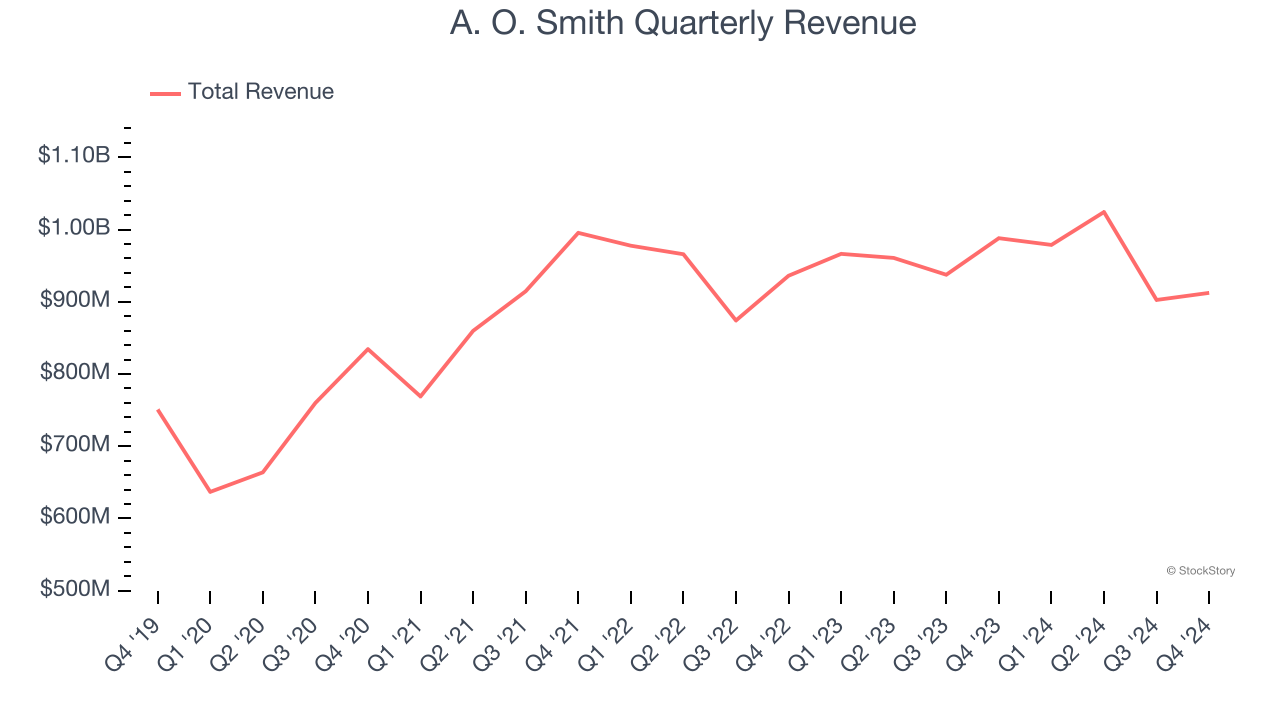
We at StockStory place the most emphasis on long-term growth, but within industrials, a half-decade historical view may miss cycles, industry trends, or a company capitalizing on catalysts such as a new contract win or a successful product line. A. O. Smith’s recent history shows its demand slowed as its revenue was flat over the last two years. 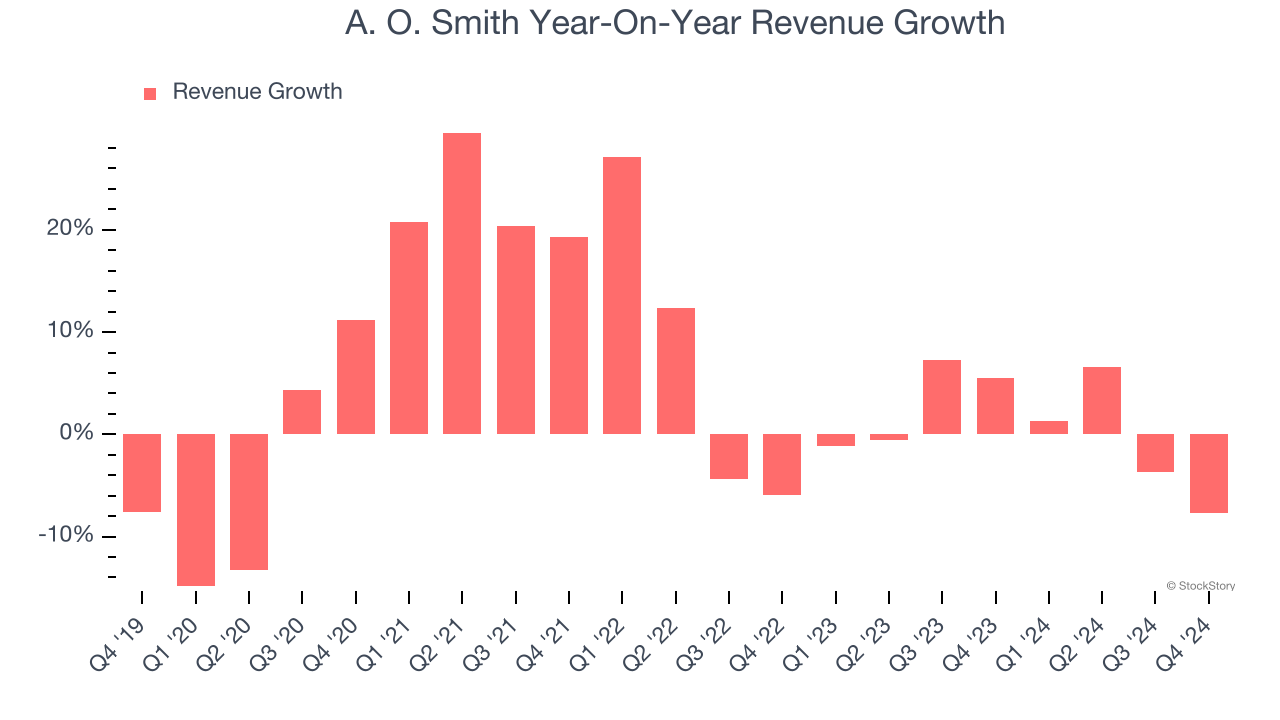
This quarter, A. O. Smith missed Wall Street’s estimates and reported a rather uninspiring 7.7% year-on-year revenue decline, generating $912.4 million of revenue.
Looking ahead, sell-side analysts expect revenue to grow 3.9% over the next 12 months. Although this projection suggests its newer products and services will catalyze better top-line performance, it is still below the sector average.
Software is eating the world and there is virtually no industry left that has been untouched by it. That drives increasing demand for tools helping software developers do their jobs, whether it be monitoring critical cloud infrastructure, integrating audio and video functionality, or ensuring smooth content streaming. Click here to access a free report on our 3 favorite stocks to play this generational megatrend.
Operating Margin
Operating margin is a key measure of profitability. Think of it as net income - the bottom line - excluding the impact of taxes and interest on debt, which are less connected to business fundamentals.
A. O. Smith has been a well-oiled machine over the last five years. It demonstrated elite profitability for an industrials business, boasting an average operating margin of 17.5%. This result isn’t surprising as its high gross margin gives it a favorable starting point.
Looking at the trend in its profitability, A. O. Smith’s operating margin rose by 3.5 percentage points over the last five years, showing its efficiency has improved.
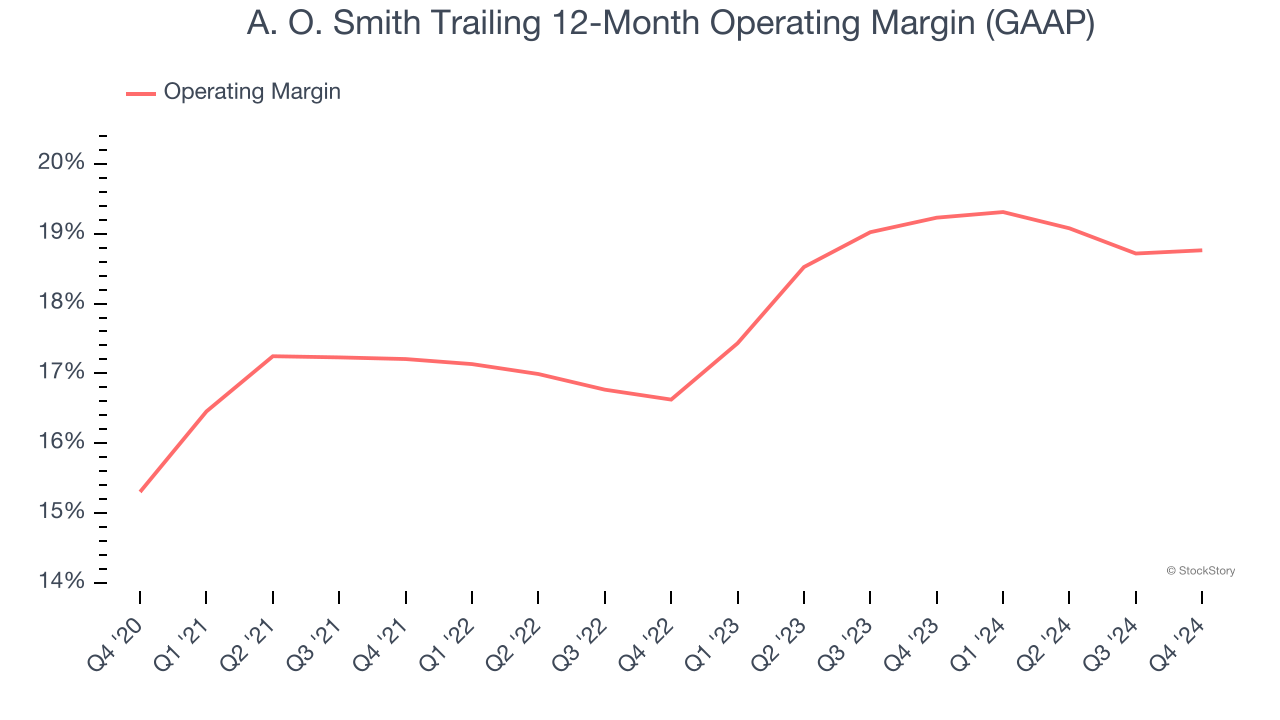
This quarter, A. O. Smith generated an operating profit margin of 17.1%, in line with the same quarter last year. This indicates the company’s cost structure has recently been stable.
Earnings Per Share
We track the long-term change in earnings per share (EPS) for the same reason as long-term revenue growth. Compared to revenue, however, EPS highlights whether a company’s growth is profitable.
A. O. Smith’s EPS grew at a solid 10.9% compounded annual growth rate over the last five years, higher than its 5% annualized revenue growth. This tells us the company became more profitable on a per-share basis as it expanded.
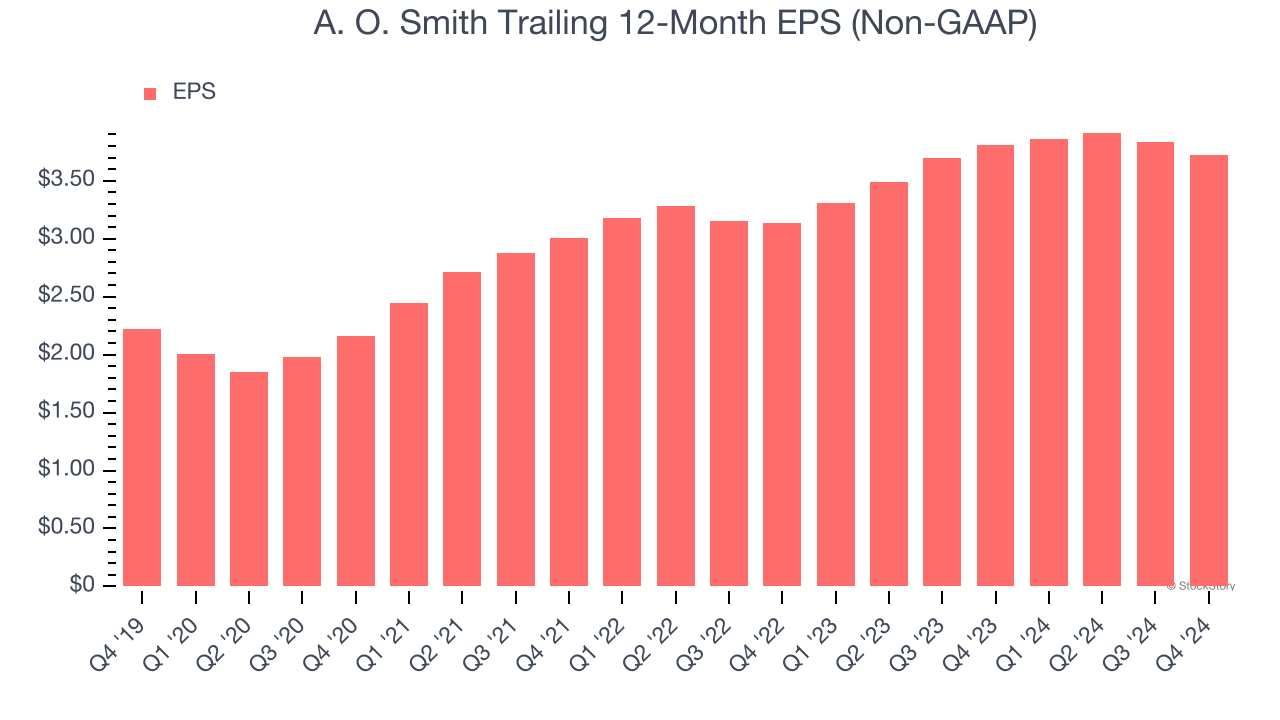
Diving into the nuances of A. O. Smith’s earnings can give us a better understanding of its performance. As we mentioned earlier, A. O. Smith’s operating margin was flat this quarter but expanded by 3.5 percentage points over the last five years. On top of that, its share count shrank by 11.2%. These are positive signs for shareholders because improving profitability and share buybacks turbocharge EPS growth relative to revenue growth. 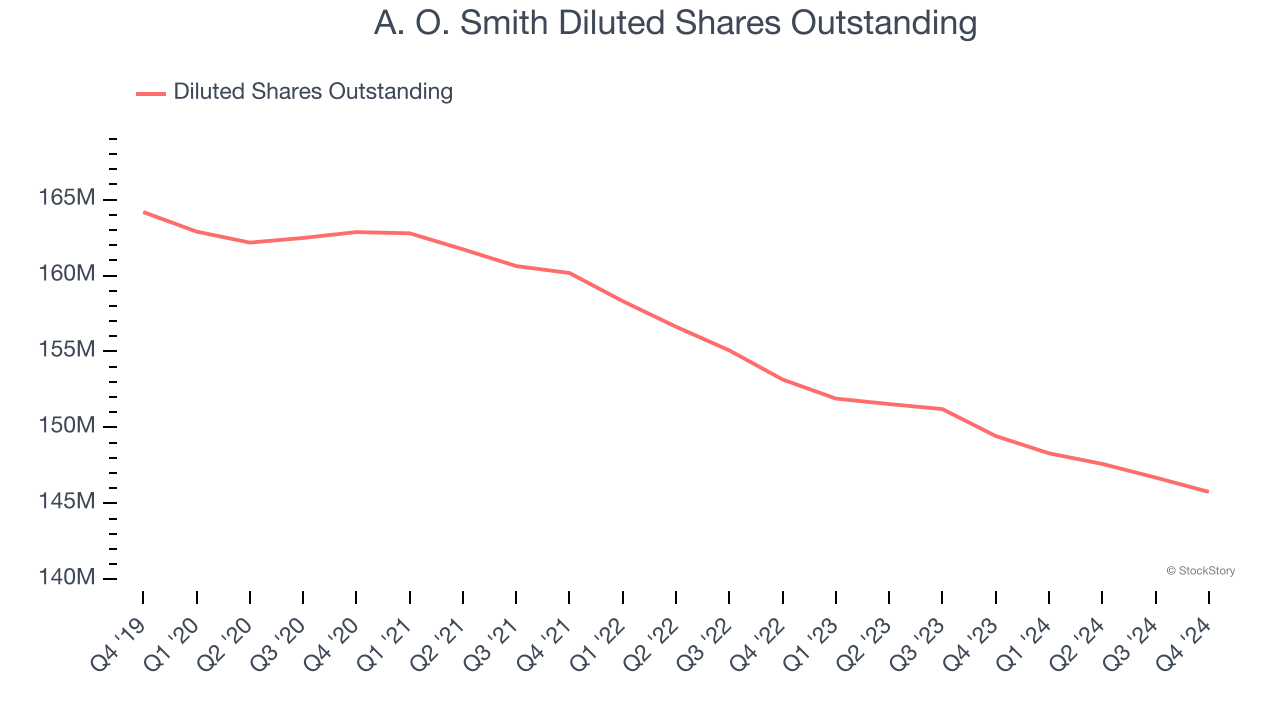
Like with revenue, we analyze EPS over a shorter period to see if we are missing a change in the business.
For A. O. Smith, its two-year annual EPS growth of 8.9% was lower than its five-year trend. We hope its growth can accelerate in the future.
In Q4, A. O. Smith reported EPS at $0.85, down from $0.97 in the same quarter last year. This print missed analysts’ estimates, but we care more about long-term EPS growth than short-term movements. Over the next 12 months, Wall Street expects A. O. Smith’s full-year EPS of $3.72 to grow 8.2%.
Key Takeaways from A. O. Smith’s Q4 Results
We struggled to find many resounding positives in these results. Its full-year revenue guidance missed significantly and its full-year EPS guidance fell short of Wall Street’s estimates. Overall, this was a softer quarter. The stock traded down 3.5% to $66.80 immediately following the results.
A. O. Smith’s earnings report left more to be desired. Let’s look forward to see if this quarter has created an opportunity to buy the stock. We think that the latest quarter is only one piece of the longer-term business quality puzzle. Quality, when combined with valuation, can help determine if the stock is a buy. We cover that in our actionable full research report which you can read here, it’s free.
